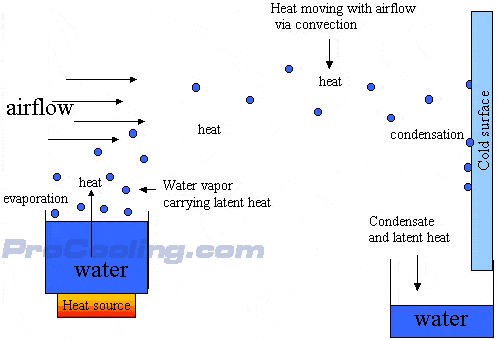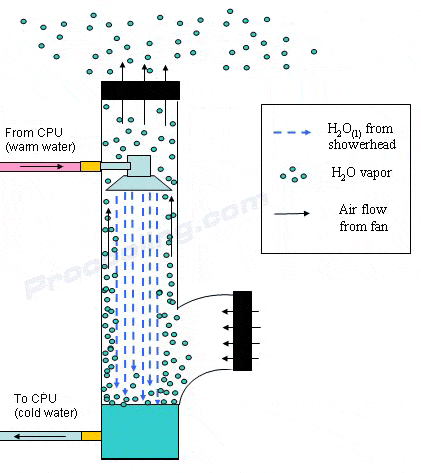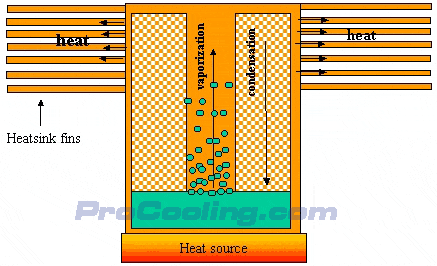|
|
|
|
 Cooling Technologies Explained Cooling Technologies Explained
|
|
Date Posted: Feb 16 2002
|
|
Author: The ProCooling Team
|
|
|
|
|
Posting Type: Article
|
|
Category: FAQ's, Editorials, Q&A's
|
|
Page: 4 of 8
|
|
Article Rank:No Rank Yet
Must Log In to Rank This Article
|
|
|
|
|
Note: This is a legacy article, imported from old code. Due to this some items on the page may not function as expected. Links, Colors, and some images may not be set correctly.
|
|
|
Cooling Technologies Explained By: The ProCooling Team
|
|
 |
|
|
3/24/02 - Team Article - By: Brian, Brad, pHaestus and Joe
|
|
|
|
|
|
|
|
|
|
|
|
|
|
|
Phase Change Cooling-(Continued) By: Brian
|
|
|
The system at this point is complete except for charging. You might use 3 oz of refrigerant or 12 oz, depending upon the size of the condenser, evaporator and amount of tubing. Use the fill point to evacuate the system first, taking time to run it for several hours after 29" (or better) vacuum is reached. Let any water boil off, because the dryer can only compensate for so much water residue. Then, charge up the system with refrigerant.
Charging a refrigeration system is easier said than done, unfortunately. Several methods can be used to determine the best charge. Some technicians watch the amperage draw for a running compressor. When the amperage reaches the "correct" amount, the system is fully and correctly charged. I prefer using a temperature gauge on the evaporator. When the evaporator is at the minimum, the system is at it's best.
Remember to be careful of overcharging! Too much refrigerant can lead to what is called "liquid slugging". It is named slugging because of the sound it makes when liquid makes it back to the compressor and for what it does to the compressor pistons. This will ruin a compressor.
Conclusion:
I hope that this article has been entertaining. I certainly don't expect a rush on refrigeration parts as people start to create their own refrigeration systems, but it might give you a better appreciation for the brave (foolish?) souls who do attempt it. Basically, it isn't worth it, unless you are dead-set on reaching really low temperatures and insane overclocking heights. Needless to say, I hope to attempt it as soon as I can!
|
|
|
|
|
Hybrid Cooling Technologies - By: pHaestus
|
|
|
There are some relatively new methods of cooling that are difficult to classify as either air, water, or phase change cooling because they combine elements from more than one cooling approach. For that reason, heat pipes and evaporative cooling will be discussed together as hybrid cooling methods. In essence, hybrid techniques improve upon either air or water cooling by adding a phase change component to the overall cooling strategy. The advantage of this kind of strategy is that in many cases hybrid cooling methods can be added into existing cooling methods with little thought for design, whereas a true phase change system has to be designed and constructed from the ground up. For example, an evaporative cooling tower simply replaces the radiator in a normal water cooling loop. Heat pipes cannot typically be added to a normal heatsink, but manufacturers such as Coolermaster have added heat pipes to their copper heatsinks without drastically affecting their design. The drawback to hybrid approaches also stems from this ease of integration into existing cooling strategies: you keep all of the drawbacks and limitations of the original cooling method and then add all of the quirks of the new.
Nonetheless, hybrid cooling strategies have definitely succeeded in pushing the limits of air and water cooling of PCs over the last year. These are very new technologies, and as long as people continue to refine and improve their design then you can expect for their popularity to continue to climb.
|
|
Evaporative Cooling
Evaporative cooling is a hybrid water/phase change cooling strategy that was developed by Steve Pignato (Xjinn) as part of a college engineering project. This cooling method works on a deceptively simple principle: Heat is required to make water evaporate. While that may seem common sense, you must also realize that water that evaporates from a liquid takes energy with it in the form of latent heat. So if water is placed in an open reservoir, and the water evaporates and carries this heat with it away from the reservoir, then the remaining water in the reservoir will be cooled. It is possible for water to drop below ambient temperature via evaporative cooling, and this combined with the enormous cooling capacity of an evaporative cooling tower make up the primary reasons that evaporative cooling has become famous.
It is important to consider that the water vapor will eventually condense (and release its energy), and on a global scale condensation (precipitation) of water that evaporates from the earth's surface is a major source of energy for the atmosphere. This concept of removing heat from a surface by evaporative cooling is also the reason that humans sweat. The body is cooled as the sweat droplets evaporate from the skin's surface. It is very important to understand how heat is transferred throughout the system, so please carefully examine the following figure:
|
|
|
 |
|
|
If you look at the figure then you should notice a few things. First of all, hopefully you noticed that cycling of energy and water occurs in the system, and that one cannot recover the water released by evaporation without also recovering the heat. This is one of the problems with evaporative cooling; the reservoir will have to be periodically refilled as water evaporates. Many complicated recovery plans relying on air cooled peltiers and even additional water cooling loops to recover the evaporated water and create a closed system have been proposed but these invariably will fail (although Rube Goldberg would be proud) because they are not considering that the system as a whole is a cycle of evaporation and condensation. When you consider the entire system in the above figure (including condensation) then you can see that this is so.
There are several factors that determine the evaporation rate from a liquid surface, including primarily relative humidity and surface area. Relative humidity is a measure of how saturated with water vapor that air is compared to how much water vapor that it can hold. This is important because water will evaporate at a much greater rate when the air is far from saturation with water. Surface area is also important, because the larger that the interface between air and water is the more rapidly that evaporation can proceed. With these two factors taken into account, Xjinn wisely designed his evaporative cooler as follows:
|
|
 |
|
|
A shower head was chosen to force the water to form many small droplets. The size of the droplets is inversely related to their surface area, so choosing a shower head that produced very fine droplets greatly increases the evaporation rate. The other thing that you will notice is the presence of a fan blowing air up and out the top of the cooling tower. This airflow serves two purposes. As far as evaporation is concerned, the air will force water vapor out of the tower and keep the air inside the tower from becoming saturated with water. The greater the removal of water vapor from the system, the greater the cooling power of the tower. The other important purpose that the airflow serves is why evaporative cooling towers can be considered a hybrid technique.
The practical implementation of evaporative cooling for CPU cooling relies not only upon the evaporation of water to remove heat, but also the transfer of heat from water to air by more conventional means. The surface area of the water droplets inside the water is so great that although the thermal conductivity of water isn't tremendous, the conduction of heat from water directly to air followed by convection of heat via airflow is still substantial. It is therefore important to optimize airflow through the system (CFM of fans chosen, the thickness and height of tower, and the spread of the water droplets). It is possible to adjust how much cooling in the evaporative tower comes from evaporation and how much from conduction of heat from water to air, and this deserves special attention as it goes to the heart of the design of the evaporative cooling tower.
It is of course possible to indefinitely increase the evaporation rate by moving to extremely small particle sizes and high CFM of air. If this is done, however, there will be difficulties in reclaiming enough water to continue through the loop and cool the CPU. On the other hand, if water merely releases heat via conduction and then this heat is removed by convective means then in essence the evaporative tower has become a normal radiator that requires much regular maintenance but presents no advantage in terms of performance. So a careful balance has to be maintained between wanting the water as far below ambient as possible and keeping the tower functional for CPU cooling.
Evaporative cooling initially became quite popular for the simple fact that it can outperform traditional radiators in heat dissipation, but this is by no means a maintenance-free solution. Many early adopters eventually returned to radiators and closed loops setups to avoid the frequent refilling of evaporative cooling towers. And the few that continued to employ evaporative cooling soon encountered another problem: accumulation of mineral (Ca and Mg carbonates) and biological solids inside their waterblocks and cooling loops. One should consider that evaporation is also a useful tool in water purification, with all of the contaminants in water remaining with the bulk liquid while the water that migrates away via evaporation is quite pure. So as water is added to the evaporative cooling setup to replace evaporated water, more and more soluble salts are added to the system as well. The concentration of these salts continues to increase until precipitation of carbonates (carbonate is always found in water open to the atmosphere) becomes an issue. Biological contaminants become a problem because the standing water of evaporative cooling towers is an ideal breeding ground for microorganisms. Regular treatment with various chemicals (a little bleach or some xenobiotic to remove biological activity and some acid or lime and rust remover to eliminate carbonates) can usually solve these problems but this means constant monitoring and maintenance of your setup.
|
|
|
Heat Pipes
Heat pipes have been employed by companies like Thermacore for many years to cool high end microprocessors in areas where extruded fin heatsinks were not sufficient. However, they are only now making their way into the PC market with new products from Zen and Coolermaster. In essence, a heat pipe is a heat spreader; it removes heat very efficiently from a small dense heat source (such as the core of an AMD CPU) to a location where it can be spread out and cooled more easily with air cooling. The heat pipe moves heat via a phase change (liquid to gas) that happens internally. To build a heat pipe, a tube is constructed that has a channel running through its center and a porous media all around the walls. A liquid that undergoes phase change at around room temperature (such as acetone) is also added. A vacuum is then pulled upon the tube (to lower the vaporization point further) and it is then sealed. A heat pipe would typically be placed vertically on top of a heat source and be connected to a powerful heatsink and fan on its top and sides. Heat would cause the liquid at the base of the heatpipe to vaporize and heat would be carried upwards with the vapor (latent heat again). Upon reaching the heatsink at the top of the heatpipe, the gas will condense, with the heat being transferred to the heatsink (to be dissipated by conventional air cooling methods) and the liquid will return to the base of the heat pipe by moving through the porous media around the sides of the heat pipe. The operation of a heat pipe can be seen in the following figure:
|
|
 |
|
|
Currently, heat pipes play a supporting role in cooling by improving the efficency of air cooling methods. However, one can easily envison heat pipes playing a more vital role in cooling if they continue to be integrated into other cooling methods. Since a major bottleneck to the cooling of modern CPUs is the obstacle of incredibly high heat densities (a large quantity of heat must be dissipated through an extremely small contact area), heat pipes present an attractive method of managing heat loads. Most implementations of Integrated Heat Spreaders (IHS) in modern processors (AMD K6-2 and 3 and the newer Intel P3 and celeron2 and all tualatin and P4 CPUs) are nothing more than copper plates that are attached to the core via pressure with some thermal interface material between the core and the heat spreader. As such, the heat spreaders function primarily as a way to protect the core from physical damage rather than as a way to improve processor cooling. In fact, brave souls who remove their heat spreaders to push the CPU's limits have repeatedly shown that the conventional heat spreaders are a barrier to heat transfer rather than a method to improve cooling efficiency. Heat pipes have the potential to change the function of the integrated heat spreader, as heat pipe technology can potentially spread heat from a very small core to a much larger area with great efficiency. In the end, this ability to move heat from its source to another remote location is what you should think of when heat pipes are mentioned.
|
|
|
Joes take on Water Cooling this way  |
|
|
|
| Random Forum Pic |
 |
| From Thread: Modding Evolution of my beige box |
|
| | ProCooling Poll: |
| So why the hell not? |
|
I agree!
|
 67% 67%
|
|
What?
|
 17% 17%
|
|
Hell NO!
|
 0% 0%
|
|
Worst Poll Ever.
|
 17% 17%
|
Total Votes:18Please Login to Vote!
|
|






 Cooling Technologies Explained
Cooling Technologies Explained



